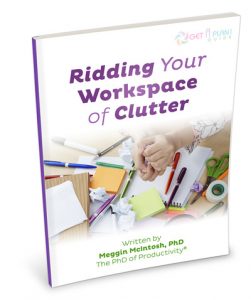Using the Concept of ‘Prime Real Estate’ at Your Desk/Workstation by Meggin McIntosh, PhD
 Developers, realtors, leasing agents, and the like are quite familiar with the concept of prime real estate. Developers don’t build “Dollar Stores” or “Big Lots” stores on land for which they paid a premium. They put high end housing, retail, or commercial property there. By considering this concept, reorganize your workspace to be more productive.
Developers, realtors, leasing agents, and the like are quite familiar with the concept of prime real estate. Developers don’t build “Dollar Stores” or “Big Lots” stores on land for which they paid a premium. They put high end housing, retail, or commercial property there. By considering this concept, reorganize your workspace to be more productive.
-
Imagine yourself sitting in the middle of a target when you are in your workspace.
-
The “A” area (or prime real estate) is the concentric circle that is the closest to you and includes the top of your desk, the top drawers in your desk, and any other spaces that you can reach easily without much movement.
-
Put items in your “A”/prime real estate area that you use every day…and put nothing else in that space. Do you really use your three-hole punch every day? If not, it and other office supplies should be moved. And do you use 10,000 pens? Donate the extras to the office conference room. Do you really use a phone book every day?
-
The “B” area (or expensive real estate) is the next concentric circle on your workspace target. This might include lower desk drawers, a credenza, or shelf that you can reach without getting up out of your chair.
-
Put items in your “B”/expensive real estate area that you use frequently, but not necessarily everyday…and put nothing else in that space.
-
The “C” area (or moderately-priced real estate) is the next concentric circle on your workspace target. This might include your file cabinets, book shelves, or other storage furniture in your office space. Important reference materials should be in this space, including perhaps a list of company personnel or other key contacts, a dictionary, etc.
-
Put items in your “C”/moderately-priced real estate area that you need to have access to but that you don’t use on a frequent basis. This is the place for your snack drawer!
-
The “D” area (or low-cost/bargain real estate) is the last and outer concentric circle on your workspace target. This might include storage outside your immediate workspace, off-site storage, or the like. Confirm the security of these materials (locking file cabinets, a safe) if they contain private information.
-
Put items in your “D”/bargain real estate area that you must keep for legal or accountability reasons, but that you don’t access except in unusual circumstances.
-
Consider your workspace areas to be fluid, i.e., something that you are working on during one part of the month may move into your “B” area, but then during the rest of the month, may move back out to the “C” area.
Think through the ideas I listed above and see what a difference it makes. Watch your productivity soar as you effectively and efficiently get your work done in your newly-organized workspace.
© Meggin McIntosh, PhD (also known as “The PhD of Productivity”®) was a university professor for over 15 years and spent five of those years working with faculty at the University of Nevada, Reno. Since leaving the full-time academic life for the full-time entrepreneurial life, Meggin writes, consults, and does workshops for smart people who want to be more productive, thereby being able to consistently keep their emphasis on excellence. Thus, the name of her company is Emphasis on Excellence, Inc.
 And if you liked these tips you may be interested in the Get a Plan! Guide® to Ridding Your Workspace of Clutter part of the Get a Plan! Guides® series designed to give you the ideas and inspiration to do your work easier, faster, and in a more focused fashion.
And if you liked these tips you may be interested in the Get a Plan! Guide® to Ridding Your Workspace of Clutter part of the Get a Plan! Guides® series designed to give you the ideas and inspiration to do your work easier, faster, and in a more focused fashion.



